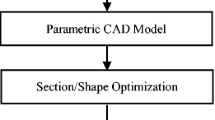Abstract
A lot of research work has been focused on integrating FEA (finite elements analysis) with CAD (Computer Aided Design) over the last decade. In spite of improvements brought by this integration, research work remains to be done in order to better integrate all the operations led during the whole design process. The design process involves several modifications of an initial design solution and until now, in this context, the communication between CAD modules (dedicated to different tasks involved in the product design process) remains static. Consequently, there is a need for more flexible communication processes between CAD modules through the design cycle, if not through the product life cycle. Some approaches have been developed aiming at the reduction of the design process length when using FEA, and aiming at the automation of part’s data transfer from one step of the process to the next one. Automatic re-meshing is one of these approaches. It consists in automatically updating the part’s mesh around modifications zones, in the case of a minor change in the part’s design, without the need to re-mesh the entire part. The purpose of this paper is to present a new tool, aiming at the improvement of automatic re-meshing procedures. This tool basically consists in automatically identifying and locating modifications between two versions of a CAD model (typically an initial design and a modified design) through the design process. The knowledge of these modifications is then used to fit portions of the initial design’s mesh to the modified design (a process referred to as automatic re-meshing). A major benefit of the approach presented here is that it is completely independent of the description frame of both models, which is made possible with the use of vector-based geometric representations.
Access this chapter
Tax calculation will be finalised at checkout
Purchases are for personal use only
Preview
Unable to display preview. Download preview PDF.
Similar content being viewed by others
References
Iyer, N., Jayanti, S., Lou, K., Kalyanaraman, Y., Ramani, K.: Three-dimensional shape searching: state-of-the-art review and future trends. Computer-Aided Design 37(5), 509–530 (2005)
Cardone, A., Gupta, S.K., Karnik, M.: A Survey of Shape Similarity Assessment Algorithms for Product Design and Manufacturing Applications. Journal of Computing and Information Science in Engineering 3(2), 109–118 (2003)
Hong, T., Lee, K., Kim, S., Chu, C., Lee, H.: Similarity comparison of mechanical parts. Computer-Aided Design and Application 2(6), 759–768 (2005)
Hilaga, M., Shinagawa, Y., Kohmura, T., Kunii, T.L.: Topology Matching for Fully Automatic Similarity Estimation of 3D Shapes. In: SIGGRAPH 2001, Los Angeles (2001)
Osada, R., Funkhouser, T.A., Chazelle, B., Dobkin, D.P.: Matching 3D Models with Shape Distributions. In: Shape Modeling International. IEEE Computer Society Press, Los Alamitos (2001)
Ohbuchi, R., Minamitani, T., Takei, T.: Shape-Similarity Search of 3D Models by using Enhanced Shape Functions. In: TPCG (2003)
Saupe, D., Vranic, D.V.: 3D model retrieval with spherical harmonics and moments. In: Radig, B., Florczyk, S. (eds.) DAGM 2001. LNCS, vol. 2191, p. 392. Springer, Heidelberg (2001)
Cicirello, V.A., Regli, W.C.: Machining Feature-Based Comparisons of Mechanical Parts. In: Shape Modeling International (2001)
Ramesh, M., Yip-Hoi, D., Dutta, D.: Feature Based Shape Similarity Measurement for Retrieval of Mechanical Parts. Journal of Computing and Information Science in Engineering 1(3), 245–257 (2001)
Francois, V., Cuilliere, J.-C.: 3D Automatic remeshing applied to model modification. Computer Aided Design 32(7), 433–444 (2000)
Serre, P., Riviere, A., Clement, A.: Geometric Product Specification and Verification: Integration of Functionality. In: Analysis of fonctional geometrical specification, pp. 115–125. Kluwer, Dordrecht (2003)
Mortenson, M.E.: Geometric Modeling (1985)
Souaissa, K., Hadjsalah, H., Benamara, A., Cuillière, J.C., Francois, V.: Outil de recherche de formes CAO identiques. In: CSME 2008, Ottawa (2008)
Serre, P., Riviere, A., Clement, A.: The clearence effect for assemblability of over-contrained mechanism. In: 8th CIRPP International Seminar on Computer Aided Tolerancing, Charlotte, USA (2003)
Clement, A., Riviere, A., Serre, P., Valade, C.: The TTRS: 13 Constraints for Dimensionning and Tolerancing. In: 5th CIRPP International Seminar on Computer Aided Tolerancing, Toronto, Canada (1997)
Piegl, L.A., Tiller, W.: The NURBS book (1997)
Francois, V., Cuilliere, J.-C.: An a priori adaptive 3D advancing front mesh generator integrated to solid modeling. In: Recent Advances in Integrated Design and Manufacturing in Mechanical Engineering, pp. 337–346 (2003)
Francois, V., Cuilliere, J.-C.: Automatic mesh pre-optimization based on the geometric discretization error. Advances in Engineering Software 31(10), 763–774 (2000)
Author information
Authors and Affiliations
Editor information
Editors and Affiliations
Rights and permissions
Copyright information
© 2009 Springer-Verlag Berlin Heidelberg
About this paper
Cite this paper
Cuillière, JC., François, V., Souaissa, K., Benamara, A., BelHadjSalah, H. (2009). Automatic CAD Models Comparison and Re-meshing in the Context of Mechanical Design Optimization. In: Clark, B.W. (eds) Proceedings of the 18th International Meshing Roundtable. Springer, Berlin, Heidelberg. https://doi.org/10.1007/978-3-642-04319-2_14
Download citation
DOI: https://doi.org/10.1007/978-3-642-04319-2_14
Publisher Name: Springer, Berlin, Heidelberg
Print ISBN: 978-3-642-04318-5
Online ISBN: 978-3-642-04319-2
eBook Packages: EngineeringEngineering (R0)





